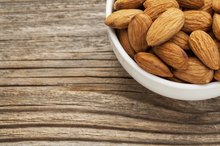Cheese Diet to Lower Triglycerides
Bloodstream triglycerides increase when you consume too many calories or carbohydrates on a daily basis. High levels of triglycerides can convert bad cholesterol (LDL) into a more dangerous form that is capable of damaging arteries. High triglycerides can also prevent the creation of good cholesterol (HDL). Weight loss and a reduced fat and carbohydrate intake can lower triglyceride levels, reducing the risk of heart disease. The right types of cheeses can play a supporting role in a low triglyceride diet.
The Good & The Bad
Reduce your carbohydrate intake if carbohydrates supply more than 40 to 45 percent of your daily calories. Start by eliminating or cutting back drastically on alcohol and food and drink high in simple sugars, such as:
- honey
- cake
- sweetened breakfast cereals,
- sodas
Good sources of carbohydrates include potatoes and rice, and whole grain breads and pastas in moderation.
Include Cheese in Your Diet
Mayo Clinic Triglyceride Diet
Learn More
To summarize, the best cheeses to include in a low triglyceride diet are those made from reduced fat or skim milk, including fresh unripened cheeses such as:
- cheddar cheese
- parmesan cheese
The Daily Diet
Of your daily caloric intake, about 25 to 30 percent should come from fat, with less than 10 percent from saturated fats. Lowering your fat intake below this amount will increase your carbohydrate intake, resulting in increased triglycerides. In addition, you should not consume more than 300mg of cholesterol each day.
About 40 to 45 percent of your daily calories should come from carbohydrates. The remaining 30 to 35 percent come from protein.
Watch your overall caloric intake. Excess calories may be converted into triglycerides whether they come from fat, carbohydrates, or protein.
For longer-lasting energy, eat balanced meals that contain protein, carbohydrates and fat, such as oatmeal and cottage cheese for breakfast. Such combinations take longer to digest than all-carbohydrate meals. Not only are these balanced meals more filling, they will also keep blood sugar levels stable, preventing sugar high crashes.
- Of your daily caloric intake, about 25 to 30 percent should come from fat, with less than 10 percent from saturated fats.
- About 40 to 45 percent of your daily calories should come from carbohydrates.
Related Articles
References
- National Dairy Council
- Schwarzova L, Hubacek JA, Vrablik M. Genetic predisposition of human plasma triglyceride concentrations. Physiol Res. 2015;64 Suppl 3:S341-54.
- Parhofer KG, Laufs U. The diagnosis and treatment of hypertriglyceridemia. Dtsch Arztebl Int. 2019;116(49):825-832.doi.10.3238/arztebl.2019.0825
- Clifton PM. Diet, exercise and weight loss and dyslipidaemia. Pathology. 2019;51(2):222-226.doi.10.1016/j.pathol.2018.10.013
- Hooper L, Summerbell CD, Thompson R, et al. Reduced or modified dietary fat for preventing cardiovascular disease. Sao Paulo Med J. 2016;134(2):182-3.doi.10.1590/1516-3180.20161342T1
- Harris KK, Zopey M, Friedman TC. Metabolic effects of smoking cessation. Nat Rev Endocrinol. 2016;12(5):299-308. doi:10.1038/nrendo.2016.32
- Brown JD, Buscemi J, Milsom V, Malcolm R, O'neil PM. Effects on cardiovascular risk factors of weight losses limited to 5-10. Transl Behav Med. 2016;6(3):339-46. doi:10.1007/s13142-015-0353-9
- Wang Y, Shen L, Xu D. Aerobic exercise reduces triglycerides by targeting apolipoprotein C3 in patients with coronary heart disease. Clin Cardiol. 2019;42(1):56-61.doi.10.1002/clc.23104
- Oh B, Sung J, Chun S. Potentially modifiable blood triglyceride levels by the control of conventional risk factors. Lipids Health Dis. 2019;18(1):222.doi:10.1186/s12944-019-1134-0
- Klop B, Do rego AT, Cabezas MC. Alcohol and plasma triglycerides. Curr Opin Lipidol. 2013;24(4):321-6.doi:10.1097/MOL.0b013e3283606845
- Nasioudis D, Doulaveris G, Kanninen TT. Dyslipidemia in pregnancy and maternal-fetal outcome. Minerva Ginecol. 2019;71(2):155-162.doi:10.23736/S0026-4784.18.04330-7
- Bello-chavolla OY, Kuri-garcía A, Ríos-ríos M, et al. Familial combined hyperlipidemia: Current knowledge, perspectives, and controversies. Rev Invest Clin. 2018;70(5):224-236.doi.10.24875/RIC.18002575
- Koopal C, Marais AD, Visseren FL. Familial dysbetalipoproteinemia: an underdiagnosed lipid disorder. Curr Opin Endocrinol Diabetes Obes. 2017;24(2):133-139.doi.10.1097/MED.0000000000000316
- Akins JD, Crawford CK, Burton HM, Wolfe AS, Vardarli E, Coyle EF. Inactivity induces resistance to the metabolic benefits following acute exercise. J Appl Physiol. 2019;126(4):1088-1094. doi:10.1152/japplphysiol.00968.2018
Writer Bio
Jane Wada's articles have appeared in the Chicago Tribune, Daily Herald, Daily South Town and the Northern Colorado Business Report. She holds a Master of Science degree in journalism from Northwestern University.









